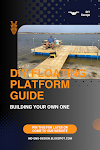Title: Harnessing Nature's Power: Building a Homemade, Simple, and Affordable Water Turbine
Harnessing the power of flowing water to generate electricity is a sustainable and environmentally friendly way to produce energy. Building a homemade water turbine offers a cost-effective solution for individuals looking to generate power from a nearby stream, river, or other water source. In this guide, we'll explore how to construct a simple and affordable water turbine using readily available materials and basic tools.
Understanding the Basics
Before diving into the construction process, it's essential to understand the basic components and principles of a water turbine:
Runner: The rotating component of the turbine, also known as the rotor, which converts the kinetic energy of flowing water into mechanical energy.
Blades: The blades of the turbine, which are designed to capture the energy of the water and transfer it to the runner. Blades can vary in shape and size depending on the specific design of the turbine.
Shaft: The central shaft of the turbine, which connects the runner to the generator or other power-generating mechanism. The shaft transfers the rotational energy from the runner to the generator.
Housing: The housing or casing that encloses the runner and blades, directing the flow of water and optimizing efficiency.
Materials and Tools
Gather the following materials and tools to build a homemade water turbine:
Materials:
- PVC pipes or other lightweight and durable materials for the turbine housing
- Plastic or metal sheeting for constructing the blades
- Bearings or bushings for mounting the shaft
- Screws, nuts, and bolts for assembly
- Waterproof sealant or epoxy for securing components
- Waterproof electrical components for connecting the turbine to a generator or battery system
Tools:
- Saw for cutting PVC pipes and sheeting
- Drill and drill bits for making holes
- Screwdriver and wrench for fastening screws and bolts
- Sandpaper for smoothing rough edges
- Measuring tape and ruler for precise measurements
- Waterproof marker for marking cutting lines
Construction Process
Follow these steps to build your own homemade water turbine:
Design the Turbine: Determine the size and specifications of your water turbine based on the available water flow and desired power output. Sketch out a design for the turbine housing, blades, and mounting mechanism, taking into account factors such as water velocity and turbine efficiency.
Cut and Assemble Components: Using the saw, cut the PVC pipes and sheeting into the desired shapes and sizes for the turbine housing and blades. Assemble the components according to your design, ensuring a secure and watertight fit.
Construct the Runner and Blades: Attach the blades to the runner using screws or bolts, ensuring they are evenly spaced and angled to capture the maximum energy from the flowing water. Test the rotation of the runner to ensure smooth movement and minimal friction.
Mount the Shaft: Install bearings or bushings on the housing to support the shaft and minimize friction during rotation. Secure the shaft in place using screws or bolts, ensuring it is centered and aligned with the runner.
Seal and Waterproof: Apply waterproof sealant or epoxy to all seams and joints in the turbine housing to prevent water leakage and ensure durability. Allow the sealant to dry completely before proceeding.
Install Electrical Components: Connect waterproof electrical components, such as wires, connectors, and terminals, to the turbine shaft for generating electricity. Ensure all connections are secure and insulated to prevent short circuits or electrical hazards.
Test and Adjust: Install the water turbine in a flowing water source, such as a stream or river, and observe its performance. Monitor the rotation speed and power output of the turbine, and make any necessary adjustments to optimize efficiency.
Monitor and Maintain: Regularly inspect the water turbine for signs of wear or damage, and perform routine maintenance as needed. Clean debris and sediment from the blades and housing to maintain optimal performance and efficiency.
Enjoying Sustainable Energy
With your homemade water turbine successfully constructed and installed, you can now harness the power of flowing water to generate clean and renewable energy for a variety of applications. Whether powering a remote cabin, charging batteries for off-grid systems, or simply experimenting with renewable energy technology, your homemade water turbine offers a practical and eco-friendly solution for harnessing nature's power. Experiment with different designs and configurations to optimize performance and efficiency, and enjoy the satisfaction of generating electricity from a sustainable and renewable source.









0 Comments